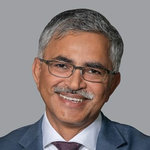
Advanced Micro Devices Inc
NASDAQ:AMD

Advanced Micro Devices Inc





In the dynamic world of semiconductor manufacturing, Advanced Micro Devices, Inc. (AMD) stands as a formidable player, innovating relentlessly in the high-tech landscape. Founded in 1969, AMD has steadily carved out a prominent position in the marketplace by delivering cutting-edge microprocessors, graphics processing units (GPUs), and related technologies. The company's journey can be likened to a strategic chess game, where each move is meticulously planned to outwit larger rivals like Intel and NVIDIA. The core of AMD's business revolves around designing and selling advanced computer processors and graphics technologies used in everything from laptops and gaming consoles to servers and workstations. By leveraging its state-of-the-art architecture, notably the "Zen" core, AMD has managed to capture market share and redefine performance standards across various computing platforms.
Under the leadership of CEO Dr. Lisa Su, AMD has shifted its focus towards high-performance computing and visualization. This pivot has been instrumental in the company's recent revenue growth. Their business model primarily hinges on licensing intellectual properties and selling integrated circuits to computer manufacturers and data centers, which are increasingly pivotal in today’s cloud-centric environment. AMD's revenue streams are primarily derived from two segments: Computing and Graphics, and Enterprise, Embedded, and Semi-Custom. The former focuses on consumer products such as PCs and graphics cards, while the latter abstracts the lucrative server and embedded solutions space. This dual-segment strategy not only diversifies AMD's offerings but also insulates it from the volatility sometimes observed in the consumer electronics market, allowing it to thrive even as macroeconomic challenges persist.
Earnings Calls
In Q1 2025, the company reported a 29% year-over-year increase in adjusted EBITDA, reaching $35.2 million, driven by robust performance in the Long Ridge unit. A notable $120 million noncash gain was tied to the acquisition of a 49.9% stake in Long Ridge. Management forecasts total annual EBITDA exceeding $330 million, with potential to surpass $400 million as new business is contracted. Long Ridge is projected to achieve approximately $160 million in EBITDA run rate by mid-year, benefitting from an additional $30 million in capacity revenue. Jefferson is expected to contribute $120 million in annual EBITDA following new long-term contracts.
Management

Dr. Lisa T. Su is a prominent business executive and electrical engineer, currently serving as the Chair, President, and CEO of Advanced Micro Devices, Inc. (AMD). She was born on November 7, 1969, in Tainan, Taiwan, and moved to the United States in her childhood. Dr. Su earned her bachelor's, master's, and doctoral degrees in electrical engineering from the Massachusetts Institute of Technology (MIT). Throughout her career, she has been recognized for her technical acumen and leadership skills. Before joining AMD, she worked at various technology companies, including Texas Instruments, IBM, and Freescale Semiconductor. Since joining AMD in 2012 as Senior Vice President and General Manager, Dr. Su has played a crucial role in reviving the company by focusing on high-performance products. She became the President and CEO in 2014 and is credited with leading AMD through a period of significant growth and transformation. Her leadership has helped AMD develop and release competitive products in the CPU and GPU markets, challenging industry leaders and significantly increasing the company's revenue and market share. Dr. Su's contributions have earned her numerous accolades, including being named one of the "World’s Greatest Leaders" by Fortune magazine and one of the "Most Powerful Women in Business." She is also a fellow of the Institute of Electrical and Electronics Engineers (IEEE) and a member of the National Academy of Engineering. Her strategic foresight and commitment to innovation continue to shape AMD's future as a leader in technology.

Jean X. Hu, Ph.D., is a prominent figure in the technology and semiconductor industry, currently serving as the Chief Financial Officer (CFO) of Advanced Micro Devices, Inc. (AMD). She joined AMD in 2023, bringing with her extensive experience in financial management and strategic planning within the tech sector. Before her role at AMD, Dr. Hu was the CFO of Marvell Technology, where she played a crucial role in driving the company’s financial strategy and contributing to its growth. Her leadership in finance extends over two decades, with significant tenures at other prominent technology firms such as QLogic, where she also held the position of CFO and served as interim CEO. Dr. Jean Hu holds a Ph.D. in Economics from Claremont Graduate University, showcasing her strong academic background, which underpins her analytical and strategic approach to finance and corporate management. At AMD, she is integral in overseeing the company’s financial initiatives, supporting its long-term growth objectives, and enhancing shareholder value. Her expertise is particularly valuable as AMD continues to expand its influence in the semiconductor industry through innovation and strategic acquisitions.

Forrest E. Norrod is a prominent executive in the semiconductor industry, currently serving as Senior Vice President and General Manager of the Data Center Solutions Group at Advanced Micro Devices, Inc. (AMD). In this role, he oversees the company’s data center products, which include the EPYC line of processors aimed at enterprise and cloud computing applications, as well as the development of next-generation server and data center solutions. Norrod joined AMD in 2014 and has played a critical role in expanding AMD's presence and competitiveness in the data center market, which has been traditionally dominated by other industry giants. His leadership has been instrumental in driving the architecture and strategy of AMD’s server technologies, focusing on performance, power efficiency, and total cost of ownership to meet the demands of modern data centers. Before joining AMD, Norrod had an extensive career at Dell, where he held several leadership positions. Most notably, he served as Vice President and General Manager of Dell’s Server Solutions, where he was responsible for directing the business and engineering operations for its server products. This experience provided him with a deep understanding of the server market and has significantly contributed to his success at AMD. Norrod's educational background includes a Bachelor’s degree in Electrical Engineering from Virginia Tech and a Master’s degree in Electrical Engineering from Stanford University. His strong technical expertise and strategic vision have significantly influenced the innovations and growth of AMD's data center business.

Philip Guido is the Executive Vice President and Chief Commercial Officer at Advanced Micro Devices, Inc. (AMD). In his role, he is responsible for developing and executing the company’s commercial strategies and ensuring alignment with its overall business objectives. He oversees the global sales organization, customer and channel partnerships, and drives initiatives that enhance customer engagement and experience. Prior to joining AMD, Guido had a distinguished career at IBM, where he operated in various senior positions and played a significant role in transforming IBM’s business units and advancing innovative solutions. His extensive experience in technology sales, business development, and executive leadership makes him a key asset to AMD's executive team. Guido holds a degree in mechanical engineering and management from Rensselaer Polytechnic Institute. His career is marked by a commitment to strategic growth, team cultivation, and a customer-centric approach, further cementing his reputation as a leader in the technology industry.

Keivan Keshvari is a prominent figure in the technology industry, particularly known for his role at Advanced Micro Devices, Inc. (AMD). At AMD, he serves as the Senior Vice President of Global Operations. In this capacity, Keshvari oversees the company’s global manufacturing and supply chain operations, ensuring seamless execution and delivery of AMD’s innovative products to the market. His leadership plays a crucial role in maintaining AMD’s competitive edge in the semiconductor industry. Keshvari brings a wealth of experience to his role, with a strong background in operations, manufacturing, and supply chain management. His strategic vision and operational expertise have been instrumental in optimizing AMD's production capabilities, enhancing efficiency, and supporting the company's growth objectives.
Philip Matthew Carter is an executive at Advanced Micro Devices Inc. (AMD), a leading global semiconductor company known for developing computer processors and related technologies for both consumer and enterprise markets. At AMD, he has held various significant leadership roles where he contributed to driving the company's strategic initiatives and growth. Carter has been instrumental in leading teams that focus on innovation, product development, and enhancing AMD's position in the highly competitive semiconductor industry. His leadership skills and experience in technology development and business strategy have played a crucial role in expanding AMD's product portfolio and market reach. Throughout his career, Carter has been known for his focus on fostering a culture of collaboration and innovation, ensuring that AMD remains at the forefront of technological advancements. His work not only helps in developing cutting-edge products but also in establishing strategic partnerships and alliances that align with the company's long-term goals. Philip Matthew Carter's contributions are recognized within the industry, highlighting his expertise in driving transformational changes and delivering value to stakeholders.

Mark D. Papermaster is an accomplished technology executive known for his role at Advanced Micro Devices, Inc. (AMD), where he serves as the Chief Technology Officer and Executive Vice President. At AMD, Papermaster is responsible for overseeing the company’s engineering, research and development, and technology strategy. His leadership focuses on driving innovation and advancing AMD's semiconductor technologies, which play a critical role in the company's competitiveness in the CPUs, graphics, and adaptive computing fields. Before joining AMD in 2011, Mark Papermaster held significant positions at several other leading technology companies. He worked at Cisco Systems, where he was a Vice President and spearheaded the company's silicon engineering group. Earlier in his career, Papermaster spent over two decades at IBM, where he contributed to the development of numerous pioneering products and eventually served as Vice President of the blade server division. Papermaster also had a notable tenure as a Senior Vice President of Devices Hardware Engineering at Apple Inc., where he was involved in the development of the iPhone and iPod hardware engineering teams. With a Bachelor’s degree in Electrical Engineering from the University of Texas at Austin and a Master’s degree in Electrical Engineering from the University of Vermont, Papermaster has a solid academic background complementing his extensive industry experience. His visionary approach and technical expertise have been instrumental in pushing forward AMD's growth and innovation in the semiconductor industry.

Mitchell J. Haws is the Vice President of Investor Relations at Advanced Micro Devices, Inc. (AMD), a position in which he plays a crucial role in communicating the company's financial strategies and performance to investors, analysts, and other stakeholders. With extensive experience in finance, Haws is responsible for managing AMD's interactions with the investment community and providing insights to support the company's growth initiatives. His leadership is pivotal in ensuring transparent and effective communication between AMD and its shareholders, contributing to the company's reputation in the financial markets. Prior to his role at AMD, Haws accrued valuable experience in investor relations and corporate finance, further enhancing his ability to drive AMD's strategic financial objectives.

Ava M. Hahn, J.D., is an accomplished executive at Advanced Micro Devices, Inc. (AMD), serving in the role of Senior Vice President, General Counsel, and Corporate Secretary. In her capacity as General Counsel, she oversees the company’s global legal matters, including corporate governance, compliance, intellectual property, and securities. Possessing a strong background in law, Ms. Hahn provides strategic guidance on various legal and business issues aligned with AMD's operations and growth objectives. Before joining AMD, she held significant legal positions at several major companies, enhancing her extensive expertise in corporate law and governance. Her educational background includes a Juris Doctor degree, which has been foundational in her ability to navigate complex legal landscapes and contribute to AMD’s leadership team effectively. Ms. Hahn's role at AMD highlights her capability in managing legal challenges and supporting the company’s innovative initiatives, demonstrating her influence and leadership in the technology sector.

















































 You don't have any saved screeners yet
You don't have any saved screeners yet

Good day, and welcome to the First Quarter 2025 FTAI Infrastructure Earnings Conference Call. As a reminder, this call is being recorded. [Operator Instructions] I would now like to turn the call over to Alan Andreini, Investor Relations. Please go ahead.
Thank you, Michelle. I would like to welcome you all to the FTAI Infrastructure Earnings Call for the first quarter of 2025. Joining me here today are Ken Nicholson, the CEO of FTAI Infrastructure; and Buck Fletcher, the company's newly appointed CFO. We have posted an investor presentation and our press release on our website, which we encourage you to download if you have not already done so. Also, please note that this call is open to the public in listen-only mode and is being webcast.
In addition, we will be discussing some non-GAAP financial measures during the call today, including adjusted EBITDA. The reconciliation of those measures to the most directly comparable GAAP measures can be found in the earnings supplement.
Before I turn the call over to Ken, I would like to point out that certain statements made today will be forward-looking statements, including regarding future earnings. These statements, by their nature, are uncertain and may differ materially from actual results.
We encourage you to review the disclaimers in our press release and investor presentation regarding non-GAAP financial measures and forward-looking statements and to review the risk factors contained in our quarterly report filed with the SEC.
Now I would like to turn the call over to Ken.
Okay. Thank you, Alan. Good morning, everyone, and welcome to our earnings call for our first quarter of 2025. As we typically do for today's call, we'll be referring to the earnings supplement, which you can find posted on our website. Before digging into the quarterly results, I'm pleased to report that our Board has authorized another quarterly dividend of $0.03 per share to be paid on May 27 to the holders of record on May 19.
I'd also like to take a minute to welcome Buck Fletcher to the company. Buck joined us officially as our new CFO in late March, and we're thrilled to have him on board. We have tremendous opportunities ahead of us on several fronts, including a number of financial and strategic objectives, and Buck comes to us with a skill set and experience that certainly will help us accomplish it all.
Now on to the financial results. Adjusted EBITDA was $35.2 million for the first quarter of 2025, up 21% from the fourth quarter and up 29% from the first quarter of last year. The quarter was a highly productive one, especially at our Long Ridge business unit, where we completed a series of important transactions that have already started to generate materially higher reported financial results.
As a result of the Long Ridge transaction, we recorded a noncash gain of $120 million, which is reflected in our financial statements, but we are excluding from adjusted EBITDA in today's financial discussion for comparative purposes.
The gain we recorded was related to purchase accounting adjustments as a result of our acquisition of our partner's 49.9% interest in late February and the resulting consolidation of Long Ridge into our financial statements going forward.
We are extremely optimistic about the year ahead. As a result of the Long Ridge activity as well as a number of other developments, we expect 2025 to be transformational for our company.
As the bar chart on the right side of Slide 3 illustrates, we continue to have a line of sight across our portfolio on approximately $190 million of incremental locked-in annual EBITDA under executed agreements, which when combined with our first quarter results represents total company annual EBITDA of over $330 million.
And the pipeline for new business continues to be healthy. If we're successful in converting new opportunities into contracted business, we continue to estimate annual EBITDA potential in excess of $400 million. Our $400 million target excludes the impact of any new investments or acquisitions we may act on, such as acquisitions at Transtar or data center developments at Long Ridge.
On Slide 4, I'll briefly talk through the key highlights at each of our companies. At Transtar, adjusted EBITDA of $19.9 million was up slightly from the fourth quarter as volumes remained steady, notwithstanding the uncertain environment surrounding tariffs and the impacts on global trade. So far in the second quarter, we continue to see stable volumes from our core U.S. steel business, and we remain focused on driving growth from third parties as well as through strategic investments.
At Long Ridge, reported EBITDA for the quarter was $18.1 million, excluding the noncash $120 million gain, which I referred to previously. Importantly, the first quarter's results reflected only a portion of the impact of the transactions we closed in late February.
We typically don't provide monthly results, but to give you a sense of the current run rate at Long Ridge, EBITDA for the month of March, which fully included the impact of the transactions, was over $10 million, approaching $130 million on an annualized basis. By midyear, we expect Long Ridge to reach annual run rate EBITDA of approximately $160 million, which includes $30 million of annual EBITDA from higher capacity revenue, which starts on June 1 of this year.
At Jefferson, EBITDA was up year-over-year, but slightly lower versus last quarter as we had 4 storage tanks off lease during the quarter, while we transitioned them to long-term service under a new, more profitable contract that commenced on April 1. EBITDA for the quarter would have exceeded $10 million had we had those 4 tanks on lease for the quarter. It's a big year ahead for Jefferson as we have $25 million of long-term annual EBITDA commencing this year under 3 contracts, all with minimum volume commitments.
And at Repauno, we recently launched the financing for our Phase 2 transloading project. We're issuing $300 million of tax-exempt debt to fund construction and a number of reserve accounts and also refinancing existing debt with a new taxable term loan.
Importantly, we recently signed an additional letter of intent for our Phase 2 project, bringing our total volumes under contract and LOI to just over 70,000 barrels per day and representing a total of approximately $80 million of annual EBITDA. Our new outlook is up $30 million from estimates we provided last quarter. Revenue from Phase 2 will commence upon completion of construction expected in late 2026.
I'll briefly walk through the balance sheet before getting into our company's quarterly results. We reported total debt of $2.8 billion at March 31. Debt at the corporate level is unchanged from last quarter at $572 million, with the rest of our debt at our business units nonrecourse to FIP. Transtar continues to be completely debt-free, while approximately $975 million of debt was at Jefferson and $73 million was at Repauno.
We now consolidate the full balance sheet of Long Ridge and reflected total long bridge debt of $1.1 billion at March 31. Upon completion of the Repauno financing, which we are planning for this month. We plan to refinance our corporate bonds and existing preferred stock and another accretive financing, which will reduce fixed charges and increased cash flow after debt service for common shareholders.
Now on to the detailed quarterly results at each of our segments, starting with Transtar on Slide 7 of the supplement. Transtar posted revenue of $42.6 million and adjusted EBITDA of $19.9 million in Q1 compared with revenue of $43.3 million and adjusted EBITDA of $19.4 million in Q4. Carloads average rates and revenues for Q1 were largely unchanged versus last quarter.
Operating expenses also continue to be stable as fuel costs and other material cost items have been largely unchanged. We expect third-party customer activity to pick up in the months to come, and we now have near-term line of sight on over a dozen third-party opportunities across Transtar's railroads, representing annual revenue of approximately $20 million and annual EBITDA of at least $10 million.
Our strategic activity continues to progress. Our M&A efforts are focused on the acquisition of complementary railroads that diversify our revenue and commodity base and open up additional growth opportunities through an expanded platform. One of our primary goals has been to leverage Transtar to make highly accretive investments, and I'm confident we'll be successful in doing so this year.
Next, on the Long Ridge, where we coupled strong operating performance in Q1 with a highly accretive refinancing and an increase in our ownership of the company. Long Ridge generated $18.1 million of EBITDA in Q1 versus $9.9 million in Q4.
Power plant capacity factor was a nearly perfect 99% for the quarter versus 87% in Q4, while gas production increased to be in line with the gas supply level required to run the power plant. We'll be bringing our West Virginia gas production online this summer, resulting in a substantial increase in gas production and allowing us to generate incremental revenue and EBITDA from excess gas sales.
As I mentioned earlier, the reported results of Q1 reflect only 1 month of the impact of the refinancing and our ownership increase. So we expect to report significantly higher results in Q2 just by virtue of reflecting 100% ownership. Also, higher capacity revenues kick in on June 1, representing approximately $30 million of additional annual EBITDA.
In addition, Long Ridge was officially fast tracked by the PJM regulator for the 20-megawatt upgrade in our power generation, meaning it's highly likely that we will receive authorization at some point here in the remainder of 2025.
With the debt refinancing and consolidation behind us, we're focused on advancing multiple behind-the-meter projects, including most notably negotiations with data center developers. Based on the current state of discussions, we anticipate entering into 1 or more transactions for data centers at Long Ridge in the coming months.
Now on to Jefferson. Jefferson generated $19.4 million of revenue and $8 million of adjusted EBITDA in Q1 versus $21.2 million of revenue and $11.1 million of EBITDA in Q4. While volumes were slightly higher in the first quarter, average pricing per barrel was lower as the mix of product included a larger proportion of lower-rate refined products.
For the duration of the first quarter, 4 of our tanks were off lease as Jefferson cleaned and transitioned those tanks to a new customer and product type, which commenced revenue service on April 1. We estimate the impact of having the tanks off lease for the quarter was approximately $2.8 million of revenue and $2.3 million of EBITDA that Jefferson did not record in the quarter.
But our focus for Jefferson is on the months ahead. As discussed, we have 3 contracts representing a total of $25 million of incremental annual EBITDA commencing this year. In addition, we are in late-stage negotiations for additional contracts with multiple parties to handle conventional crude and refined products as well as renewable fuels, with some of these negotiations involving business that would still commence in 2025.
If we're successful in converting those opportunities to business wins, we will be in a position to post annual EBITDA of approximately $120 million.
Closing out with Repauno, our commercial progress for Phase 2 is proceeding well. We have 2 customers signed up under long-term contracts and an additional customer under a letter of intent that we expect to convert to a long-term contract this summer.
In the aggregate, these 3 pieces of business represent minimum volumes of 71,000 barrels per day and approximately $80 million of annual EBITDA for Phase 2. The 2 contracts are each for 5-year terms, commencing upon completion of Phase 2 construction, while the third letter of intent is for 5 years with a 2-year extension option at the option of our customer.
As I previously mentioned, financing for Phase 2 construction is underway with Repauno's $300 million tax-exempt debt issuance currently in the market, and we expect to price and close the financing in this month of May.
While Phase 2 remains our current priority, we're excited about the advancement of the next phase of Repauno, including the development of additional underground storage for which we expect to complete permitting in the months to come.
To wrap up, we're pleased with the quarter and excited about the year ahead, and I will now turn the call back over to Alan.
Thank you, Ken. Michelle, you may now open the call to Q&A.
[Operator Instructions] our first question comes from Giuliano Bologna with Compass Point.
Congrats on the continued progress across the asset base. Maybe starting off on Repauno, I'm curious, how much longer after the public hearing on May 14 do you estimate take for the cavern approvals to come through?
Giuliano, yes, we're very, very close. I'm excited about it. Typically, it's a 30-day wait after the hearing date. There's a period that the final permit has to sit after the hearing, but it's typically a 30-day process. That is not sort of preordained, but we expect it to be 30 days, maybe 45 days max before we actually have the permit in hand.
So it's conceivable, as quickly as we have that permanent hand, we'll complete engineering and construction contracting, and we could be underway on Phase 3 actually later this year.
That's great. Very helpful. And then pivoting over to Long Ridge, can you just describe the type of data center deals that you're working on Long Ridge? And what those will look like?
Yes, definitely. Very active. The various conversations we're having all have slightly different potential structures, but I would say the most typical structure would be where we would lease or sell the land that we own adjacent to the power plant and in addition, build and provide backup power to a data center developer.
What that would mean is there would not be a need to disconnect our existing 485-megawatt power plant from the grid. That's a good thing because that's an element of the transaction that could be subject to timing and a regulatory process. So by doing it this way, data center developers can be up and running more quickly.
And at the end of the day, it would allow us to maintain our existing, call it, $160 million of EBITDA from the existing plant and gas and then generate incremental EBITDA from the lease of land and the supply of backup power. I think we've said before, our estimates are that incremental EBITDA above and beyond the existing $160 million, we estimate to be in the $70 million plus or minus annual range.
It's very helpful. I appreciate that. And then switching over to Transtar, I'm curious if you have any update on the Nippon deal or anything about how things should play out there from an upside perspective related to the transaction?
Yes. Well, look, we're encouraged by the latest out of Washington. You might have seen President Trump ordered CFIUS to spend a 45-day period to subject the Nippon acquisition of U.S. Steel, again, to an examination. He did that -- I think it was back on April 6. And so if you count 45 days from April 6, that gets us to about 2 weeks from today. So we're eager to hear what the findings are.
I mean the atmospherics, generally, are positive. I think we've always said if Nippon is approved or otherwise an investment by Nippon is approved, that can only be a good thing. It's not necessarily a bad thing for Transtar if it goes the other way, but it's probably an incrementally good thing if Nippon is approved to make an investment or otherwise acquire U.S. Steel.
Our next question comes from Brian McKenna with Citizens.
I hope everyone is doing well. The situation clearly remains fluid here. But Ken, based on everything that we know today, I mean, can you just walk through some of the puts and takes from the tariffs on your business? I know there's some positives, maybe some negatives, but it'd just be helpful to get the latest here.
Yes. Brian, the -- I think the answer to the question is it depends. It is, of course, an uncertain environment. I think certain of our businesses are positioned to benefit from the direction global trade is going, particularly as it relates to our assets that have more direct exposure to the international energy markets and flows.
You may have seen President Trump a number of weeks ago, stated that one of his primary goals was, through all of this, to have it end up where Europe was committing to purchase more energy products from the United States. And I think he quoted up to $350 billion of energy products every year. Repauno is, obviously, best positioned to take advantage of that with natural gas liquids being shipped out of the East Coast to the European market.
So I will tell you, we have seen some positive indications at Repauno in particular and some increase in interest. We've -- as I mentioned on the call, we've signed 3 contracts and an LOI over the past several, several months. Each consecutive signing has come at a higher rate.
And as we've been utilizing supply and our remaining supply has diminished, we've seen customers willing to pay more for the declining supply that we have. That's a good sign. People want to make sure they have the supply available at Repauno or anywhere in the event energy flows to Europe pick up in the coming months. So encouraged by Repauno.
At the same time, Jefferson is also an export terminal. We export waxy crudes out of Utah. And so that business, I think, could also benefit.
Transtar, it's certainly a potential benefit. I mean there was certainly some good news out of the negotiations with Great Britain yesterday for steel imports into Great Britain from the U.S. looking to increase. I can't say that Gary and Mon Valley complexes at Transtar are big players in the export markets, but that doesn't mean that they couldn't be. And so that's probably only a good thing as well.
At Long Ridge, we're more focused on our internal business there and the things that we're doing. And so I'm not sure tariffs are a huge plus or minus at Long Ridge, but I think we have a lot of opportunity Long Ridge, obviously, regardless of whatever happens on the international market.
Okay. Super helpful. And then maybe just following up on Repauno, and it's good to hear all that positive commentary, and it's good to see the incremental $30 million of adjusted EBITDA from that third contract. Is there any remaining capacity to contract beyond what you have today?
And then thinking about the upside potential from Phase 2, I mean is that $80 million at the top end of the range? Or could there actually be some upside to that longer term?
The -- there's not a tremendous amount of available capacity above and beyond the 70,000 barrels we have contracted at under LOI for Phase 2. Where there is available capacity is remaining at Phase 1. I'll give you a sort of an example.
For Phase 1, which, of course, is operating today, we have a contract with a customer who is committed to minimum volumes of 8,500 barrels per day. That customer just recently nominated for next month, I think it was over 13,000 barrels per day. We have the total capacity to handle over 20,000 barrels per day for Phase 1.
And so that is underutilized, and there's definitely upside for Phase 1, I think another, call it, annual $10 million EBITDA out of Phase 1 if we can increase utilization closer to the 80%, 90%.
Phase 2, the 70,000 barrels that we have in place is not a lot of remaining capacity, based on the design of Phase 2. That would have to come from Phase 3 in the future.
Yes. Got it. Okay. And then just the last one for me. The 20-megawatt increase at the power plant, Long Ridge. Great to hear that, that's been fast tracked. I think you said it should be authorized at some point later in 2025. I mean are there any other -- any more specifics you can give here? Is it 3Q, 4Q? Just trying to think through that. And then can you just remind us on the incremental earnings from the increase here?
Yes. It would likely be 4Q. I don't think it will be 3Q. It's a great sign. I mean, our confidence level now regarding the approval for the uprate is extremely high. There were a number of plants in the PJM that were on the list for being fast tracked, and many did not get chosen, we did, and that's just -- that's very encouraging.
It's about $8 million of incremental EBITDA upon the uprate. The uprate requires no capital, it could happen effectively overnight. It's a quick software change.
The turbine is certainly capable today of generating up to 505 megawatts. So as soon as we're approved, we'll turn it on. Timing is not a definitive thing with the PJM. There's no specific guidance on the timetable. Based on everything we're hearing, I would expect it would be late this year.
Thank you. Our next question comes from Greg Lewis with BTIG.
[ Joe ], I was hoping to get a little bit more color around Transtar, i.e. the $10 million of adjusted EBITDA side. Is that -- I guess a couple of things there. Is that going to require any CapEx on the part of Transtar? Or is that just really squeezing more money out of the existing footprint?
It is -- no additional capital. Nothing -- certainly, no material additional capital. We're talking maybe tens of thousands of dollars or $100,000 for a certain project here or there. There are, as I said, over a dozen projects, we keep an active list. That active list probably has 30 to 40 opportunities. But in terms of the near-term activities that we expect to turn on this year, it's well over a dozen.
The opportunities are across a number of the railroads at Transtar. Some -- most are regarding new freight business, transloading to just serving new customers. And then a portion, I would say, maybe 20% of the opportunities are additional mechanical work, primarily at our new car repair shop on the Union Railroad in the Pittsburgh area.
So it's nice to have diversity across many different railroads. We've -- these are the types of things where you have to pursue them for a number of months before they actually kick in and come to fruition. But once they've kicked in, they tend to be very sticky.
And so we're always adding to the list of opportunities and been staffing up at Transtar. So I'm pretty encouraged. I think we're going to have some good momentum ahead.
Okay. Great to hear. And then a little bit of a broad question, but you called out the $2 million off-hire at Jefferson. Are there -- as we look out over the next few quarters, just so we're kind of all on the same page, are there any other contract roll-offs across, I guess, maybe Transtar, Jefferson, I don't think, Long Ridge; or planned maintenances that we should be aware of as we look out over the next couple of quarters?
Nothing across Jefferson. The only consistent maintenance outages we have are really at Long Ridge, where every 6 months or so, we have a brief maintenance outage that can last anywhere from 3, 4, 5 days to up to 10 days or so. It's a pretty typical thing, it's required. And we take those maintenance outages every 6 months.
We try to manage to take those outages at times when we can dovetail it nicely with gas production or otherwise, so that it has a minimal financial impact. We are going to take a maintenance outage here in the second quarter at Long Ridge.
Again, don't expect it to have a material financial impact for the quarter. We expect certainly the full impact of the consolidation of Long Ridge to, by far, overwhelm any impact from a maintenance outage. Outside of that, no, no meaningful contract roles or episodes like we had in the first quarter with Jefferson.
Thank you. I'm showing no further questions at this time. I'd like to turn the call back over to Alan Andreini for closing remarks.
Thank you, Michelle, and thank you all for participating in today's call. We look forward to updating you after Q2.
Thank you for your participation. You may now disconnect. Everyone, have a great day.